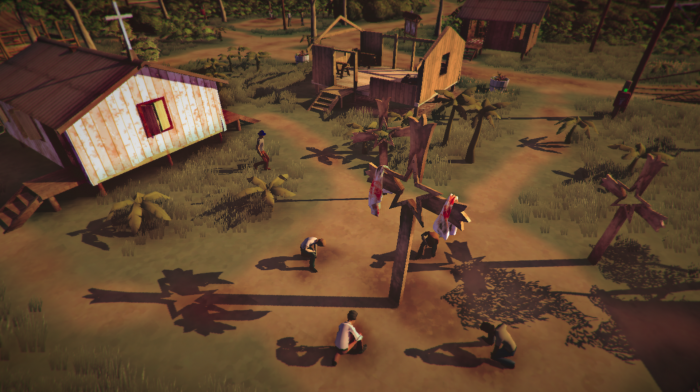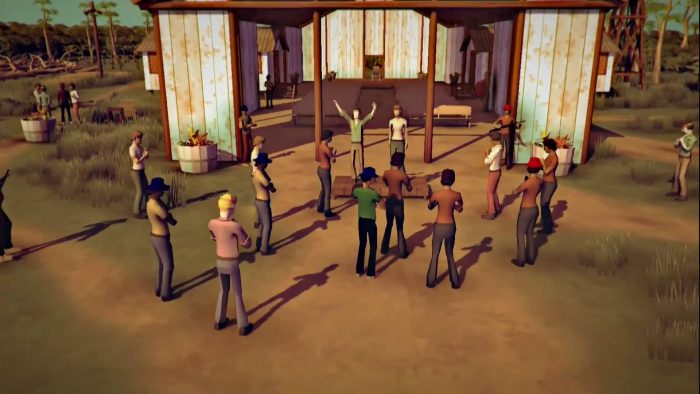I wasn’t sure what I was gonna get when I sat down to check out Paranoid Productions’ The Church in the Darkness. On paper, the concept sounded cool, as someone who is endlessly fascinated by doomsday cults, I loved the base premise, but as we’ve seen with plenty of games who claim to have something to say about that kind of subject matter (most recently Far Cry 5), it can be very easy to just generalize and drop the ball, and as such I was ready to leave disappointed.
That said, The Church in the Darkness satisfied my hopes and then some.
The game sees you assume the role of someone searching a South American jungle commune for a relative who’s seemingly joined up with an extremist group called the Collective Justice Mission.
While the developers seemingly made a point not to mention it by name and the game itself doesn’t explicitly reference it, the infamous Jonestown cult of the 1970s, the same cult that ultimately resulted in the murder and mass suicide of over 900 men, women and children in its Guyana commune, is clearly the direct inspiration for the title. Hell, the opening titles start with a timeline of events that basically mirror the ascent of Jonestown’s namesake, Jim Jones, which to me isn’t a bad thing at all.
 The vibe set by the setting is equally fascinating and unsettling. Documents found in cabins and other parts of the environment give you a deeper look into the more sinister goings-ons, and there’s a near constant, ever-present stream of propaganda coming from the commune’s loudspeakers. It’s something that managed to make me feel a bit uneasy and on edge even when there were no hostile entities in my immediate vicinity.
The vibe set by the setting is equally fascinating and unsettling. Documents found in cabins and other parts of the environment give you a deeper look into the more sinister goings-ons, and there’s a near constant, ever-present stream of propaganda coming from the commune’s loudspeakers. It’s something that managed to make me feel a bit uneasy and on edge even when there were no hostile entities in my immediate vicinity.
Vibe aside, the gameplay is simple, and not what I expected upon first glance. It’s less of an adventure game and more of an isometric stealth game along the lines of classics like Metal Gear Solid: VR Missions, which, being one of my all-time favorite series and genres, I instantly clicked with.
The gameplay more or less consists of navigating the commune and trying not to get spotted or taken out by hostile forces. Much like other games in the genre, you have various options at your disposal to aid you in getting to your goal. You can toggle enemy vision cones on and off by holding a face button, which will also let you see how much of a threat the area’s NPCs are, ranging from red to green, with green NPCs being chill enough to go and talk to in order to get assistance or side quests from.
You also have the option to toss something to distract guards, which you can then sneak up behind and take out in a lethal or non-lethal way, with the non-lethal method only knocking enemies out momentarily so you’d need to hustle out fast, rather than finding a box or closet to hide a body in.
 If all else fails, you have a gun, which is damn lethal, as you would imagine, but is also loud and gets a lot of attention, so it should be saved as a last resort. It’s worth noting that the firearm combat doesn’t feel or work particularly well, but honestly if you’re planning on using guns a lot in a game like this you’re probably approaching it the wrong way.
If all else fails, you have a gun, which is damn lethal, as you would imagine, but is also loud and gets a lot of attention, so it should be saved as a last resort. It’s worth noting that the firearm combat doesn’t feel or work particularly well, but honestly if you’re planning on using guns a lot in a game like this you’re probably approaching it the wrong way.
In my play through the commune was populated by a more hostile kind of death cult, which made for a more engaging and challenging demo, but I was assured that as each playthrough is procedurally generated, that won’t always be the case. It’s ultimately going to be up to context clues and documents to help you figure out which is which. As a general rule of thumb, though, if you come across cult members tying people up and murdering them in the woods, they’re probably the bad guys.
I was hoping for something that felt fresh and unexpected when I sat down to try The Church in the Darkness, and I have to say I got what I came for. The pure stealth gameplay is coming along very nicely, and even though the combat leaves something to be desired, that’s not really what I come to games like this for, and I can’t wait to see how everything comes together in the final product.

![[PAX East] The Church in the Darkness offers an unsettling tale of doomsday cults and classic stealth action](https://www.sidequesting.com/wp-content/uploads/TheChurchInTheDarkness-FreedomTownSign.jpg)

No Comments